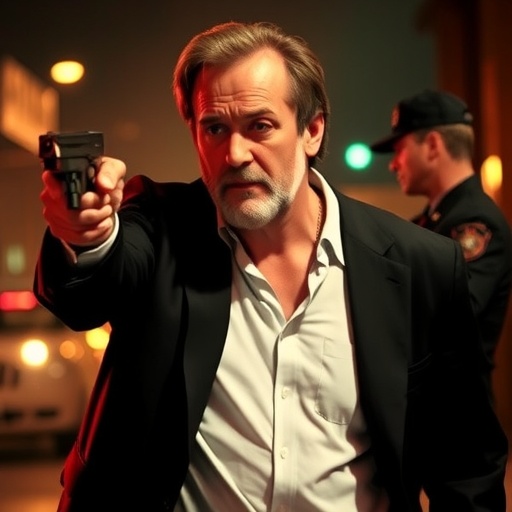Michael Mann’s ‘Heat 2‘ Greenlit for Los Angeles Filming with $37.2 Million Tax Incentive Windfall
In a major win for Hollywood’s comeback story, director Michael Mann’s long-awaited sequel Heat 2 is officially set to roll cameras in Los Angeles, thanks to a whopping $37.2 million tax incentive from the state of California. This funding, part of the state’s expanded film credit program, not only secures the high-octane project’s production in the City of Angels but also underscores a revitalized push to keep big-budget film production on American soil amid global competition.
- California’s Tax Incentive Program Delivers Big for ‘Heat 2’ Production
- Michael Mann Returns to Los Angeles Roots with ‘Heat 2’ Sequel Vision
- Economic Surge: How ‘Heat 2’ Tax Incentive Fuels Los Angeles Film Jobs
- Competitive Edge: ‘Heat 2’ Joins Wave of Incentive-Driven Hollywood Returns
- Looking Ahead: ‘Heat 2’ Filming Timeline and Hollywood’s Brighter Future
The announcement comes as California intensifies efforts to lure back blockbuster shoots that have increasingly migrated to tax-friendly locales like Georgia and Canada. For fans of the 1995 crime epic Heat, which pitted Al Pacino against Robert De Niro in one of cinema’s most iconic showdowns, this news reignites excitement over a sequel that has been in the works for years. Michael Mann, the visionary behind the original, co-authored the novelization of Heat 2 with Meg Gardiner in 2022, setting the stage for a cinematic expansion that promises to delve deeper into the gritty underworld of Los Angeles.
With principal photography slated to begin in early 2025, the project is expected to inject millions into the local economy, creating jobs for thousands of crew members, actors, and support staff. This tax incentive isn’t just a financial boon—it’s a strategic move to cement Los Angeles as the epicenter of film production once again.
California’s Tax Incentive Program Delivers Big for ‘Heat 2’ Production
California’s Film and Television Tax Credit Program has been a game-changer since its inception in 2009, but the latest expansion under Governor Gavin Newsom has supercharged its impact. Allocated $330 million annually as of 2020, the program now offers rebates up to 35% on qualified spending for productions shooting at least 75% within the state. For Heat 2, this translates to the $37.2 million incentive, covering a significant portion of the film’s estimated $200 million budget.
“This is a testament to California’s commitment to its creative industries,” said FilmLA President Paul Audley in a recent statement. “By securing Heat 2, we’re not only bringing Michael Mann’s masterpiece back home but also fostering a sustainable ecosystem for film production in Los Angeles.” The incentive was awarded after a competitive application process, where the production team demonstrated how filming in L.A. would maximize local hires and spending.
Historically, the program has supported over 100 major projects, generating more than $26 billion in economic activity since 2015. Notable beneficiaries include Avatar: The Way of Water, which snagged $101 million in credits, and recent hits like Top Gun: Maverick. For Heat 2, the focus on Los Angeles locations— from the bustling freeways of the 101 to the shadowy alleys of downtown—aligns perfectly with the program’s goals of authentic, place-based storytelling.
Experts point out that without such incentives, projects like this could easily decamp to Atlanta, where Georgia’s 30% tax credit has lured away scores of Hollywood productions. In 2023 alone, California captured 20% of qualified applicants, a sharp rise from previous years, thanks to the program’s broadened eligibility for streaming and theatrical releases. Michael Mann’s team navigated this landscape adeptly, emphasizing how Heat 2‘s narrative roots in L.A.’s underbelly make it an ideal fit.
The tax incentive structure breaks down into transferable credits, meaning the production can sell unused portions to other taxpayers for immediate cash flow. This flexibility has been crucial for Heat 2, allowing Warner Bros., the studio behind the project, to allocate resources toward practical effects and location shoots that capture the sequel’s high-stakes heists and pursuits.
Michael Mann Returns to Los Angeles Roots with ‘Heat 2’ Sequel Vision
Michael Mann, the 81-year-old auteur known for his meticulous craftsmanship in films like Collateral and The Insider, has always drawn inspiration from Los Angeles. The original Heat was a love letter to the city, transforming its concrete jungles into a character unto itself. Now, with Heat 2, Mann is poised to revisit those streets, expanding the timeline to explore prequels and sequels involving characters like Neil McCauley (De Niro) and Vincent Hanna (Pacino).
In interviews leading up to the announcement, Mann expressed his enthusiasm for shooting in Los Angeles. “L.A. is the soul of this story,” he told Variety magazine. “The energy, the diversity, the raw pulse—it’s irreplaceable. This tax incentive makes it possible to honor that authenticity without compromise.” The sequel’s script, adapted from the bestseller novel, promises intense action sequences filmed on location, including recreations of the infamous downtown bank robbery from the first film.
Mann’s career trajectory adds layers to this project. After Heat‘s release, which grossed over $187 million worldwide and earned Pacino and De Niro Oscar buzz, Mann ventured into digital filmmaking with Public Enemies. Yet, Heat 2 marks his return to the crime thriller genre that defined his early success. Casting rumors swirl around returning stars and newcomers, with Pacino confirmed to reprise Hanna in flashback sequences, while potential leads like Austin Butler or Chris Hemsworth are being eyed for younger iterations of key roles.
Los Angeles serves not just as a backdrop but as a narrative driver. The film’s plot spans from 1988 to 2000, weaving in real L.A. events like the Northridge earthquake and the rise of tech booms, all while maintaining the tense cat-and-mouse dynamic that made the original a classic. Mann’s insistence on practical stunts— no heavy reliance on green screens— means local VFX houses and stunt coordinators will see a surge in work, further tying the production to the city’s fabric.
Behind the scenes, Mann has collaborated with cinematographer Dante Spinotti, a frequent partner, to capture L.A.’s nocturnal glow. This commitment to on-location filming aligns with the tax incentive’s requirements, ensuring that Heat 2 contributes to the preservation of Hollywood’s traditional crafts amid the rise of virtual production.
Economic Surge: How ‘Heat 2’ Tax Incentive Fuels Los Angeles Film Jobs
The $37.2 million tax incentive for Heat 2 is more than a line item—it’s a catalyst for economic revival in Los Angeles, a city hit hard by the post-pandemic production slump and runaway film trends. According to the California Film Commission, every dollar of tax credits generates $6.70 in economic output, with Heat 2 projected to spend over $150 million locally on wages, rentals, and services.
This influx will create upwards of 2,500 jobs, from grips and gaffers to costume designers and caterers. Unions like IATSE Local 80, which represents studio grips, have praised the move. “Projects like Heat 2 under Michael Mann bring steady work back to our members,” said union rep Thomas Sanders. “It’s about building careers, not just one-off gigs.” Los Angeles, home to over 700,000 jobs tied to the entertainment industry, saw a 15% dip in on-location shooting permits in 2023; incentives like this could reverse that trend.
Beyond direct employment, the ripple effects touch hospitality and real estate. Hotels in areas like Hollywood and Downtown L.A. anticipate bookings for cast and crew, while soundstages at Warner Bros. Studios in Burbank gear up for extended use. A 2022 study by the Otis College of Art and Design highlighted how film production supports 1 in 10 jobs in L.A. County, with diverse hiring in recent years boosting underrepresented communities.
Comparatively, when Heat filmed in 1995, it employed over 1,000 locals and spent $40 million—adjusted for inflation, that’s about $80 million today. Heat 2 scales that up, incorporating modern sustainability practices mandated by the tax program, such as electric vehicles for transports and zero-waste sets. This not only cuts costs but appeals to eco-conscious talent.
Small businesses stand to gain too. Location scouts have already identified spots in Echo Park and Silver Lake for night shoots, driving traffic to nearby eateries and shops. The Los Angeles Economic Development Corporation estimates that a single major production can boost GDP by $100 million in indirect spending, underscoring why lobbying for these incentives has become a bipartisan priority in Sacramento.
Competitive Edge: ‘Heat 2’ Joins Wave of Incentive-Driven Hollywood Returns
Heat 2‘s Los Angeles commitment positions it alongside a burgeoning slate of productions leveraging California’s tax incentives, signaling a shift in Hollywood’s geography. In the past year, the program greenlit 25 projects worth $2.5 billion in spending, including Fast X sequels and Netflix’s Stranger Things spin-offs. Michael Mann’s film joins this elite group, outbidding proposals from international locales.
The competitive landscape is fierce. New York offers up to 30% credits, while New Mexico touts 40% rebates, but California’s edge lies in its infrastructure— from Paramount’s backlots to the skilled labor pool. “Los Angeles isn’t just a set; it’s a talent magnet,” noted entertainment analyst Pamela Levine. For Heat 2, this means seamless access to Mann’s preferred collaborators, reducing relocation headaches.
Challenges persist, however. Rising costs in L.A., including a 20% hike in permit fees since 2020, have deterred some. Yet, the tax incentive mitigates this, with Heat 2‘s package including bonuses for hiring veterans and locals from underserved areas. Warner Bros. executives have hinted at spin-off potential, eyeing TV extensions that could prolong the economic boost.
Globally, the U.S. film industry faces pressure from subsidies abroad— the UK’s 25% credit drew Barbie parts, for instance. California’s response? Doubling down, with proposals to hike the annual fund to $750 million by 2025. Heat 2 exemplifies success: its novel sold 500,000 copies in weeks, building hype that translates to box-office gold.
Stakeholders like the Hollywood Chamber of Commerce celebrate this as a “return to roots.” As one producer quipped, “Michael Mann shooting in L.A. is like the Lakers playing at Staples— it’s where the magic happens.” This wave could reclaim 10% of lost productions by 2026, per industry forecasts.
Looking Ahead: ‘Heat 2’ Filming Timeline and Hollywood’s Brighter Future
As Heat 2 gears up for its Los Angeles shoot, the production timeline outlines a meticulous path forward. Pre-production ramps up in Q1 2025, with location scouting and casting finalizations wrapping by spring. Principal photography, spanning 120 days, will hit L.A. streets from June to October, capturing summer heat for authenticity— a nod to the original’s sweltering vibe.
Mann plans post-production at his L.A.-based company, aiming for a 2027 release to coincide with the original’s 32nd anniversary. Marketing will leverage nostalgia, with trailers teasing De Niro and Pacino cameos. Warner Bros. eyes a $300 million global haul, bolstered by IMAX formats for action scenes.
The broader implications for film production are profound. This tax incentive success could inspire similar deals for Mann’s next ventures, while encouraging studios to prioritize domestic shoots. With streaming wars cooling, theatrical epics like Heat 2 may lead a renaissance, drawing talent back to Los Angeles.
Ultimately, as California refines its program— perhaps adding diversity quotas or green tech bonuses— projects like this will sustain the dream factory. For Michael Mann, it’s a homecoming; for Hollywood, a blueprint for endurance in a changing industry.










